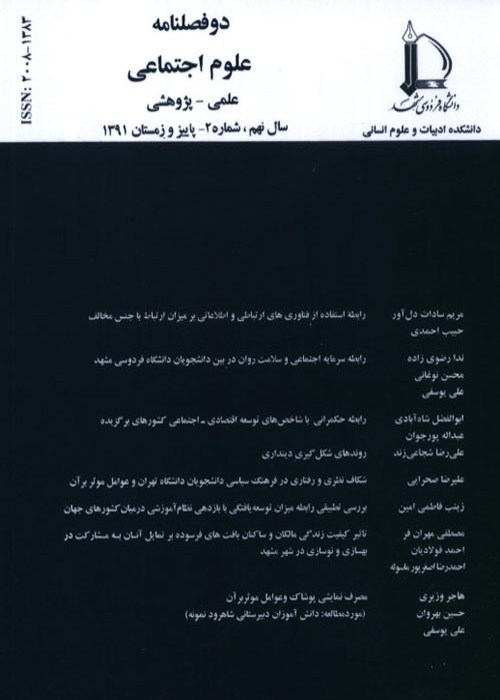Structural Modeling of Environmental Attitude and Experience Impact on Environmental Behavior
Author(s):
Abstract:
Introduction
Study about environmental behavior and its effective factors is the basic issue in environmental sociology. Most studies emphasize on attitudes, knowledge and awareness about environment ant its risks. Few of them have focused on other social and environmental factors such as direct environmental experience. It seems that we cannot predict the type of environmental behavior, just with awareness about type of environmental values accepted by the people, the level of environmental knowledge and environmental attitudes of them. Thus, other social and environmental factors should be considered in explaining the type of environmental behavior of citizens. Therefore, it is possible that the physical characteristics of natural environment in which people present in their daily lives and type of relationship between natural environment and individuals, effect on environmental attitudes and behaviors. The purpose of this paper is to examine the relationship between environmental attitude (EA), environmental experience (EE) and environmental behavior (EB). In addition, in this article the effect of EA as a mediating variable was studied. Therefore, the basic motivation of this study can raise the following question: Is environmental experience an effective factor on responsible environmental attitude and behavior?Theoretical Framework: This paper claims that new environmental paradigm and post materialism values approach follow the simplest model that explains environmental behavior (American model). In this model, linear sequence of environmental knowledge, environmental attitude and environmental behavior is assumed. This research puts aside that usual optimism in environmental sociology and looks for other factor besides environmental attitude in shaping the environmental behavior. Duerden, Witt and Kellert claims direct experience of natural environment impacts on individuals environmental attitude and behavior.
Methodology
Methodologically, this paper is an extensive study and in terms of time is a sectional one. The statistical population includes 15 to 75 year old citizens of Tabriz and the sample size is 442, which was selected by cluster sampling. Also, the type of this research is an applied one, method used in research is survey and the technique for gathering data is questionnaire. Validity of questionnaire was checked with factor analysis and reliability of that was checked whit cronbachs alpha. All of cronbachs alpha are higher than 0.6, so reliability of indices, dimensions and variables is confirmed. Environmental behavior was measured by Stern's questionnaire (2000) and Milfont and Duckitt's questionnaire (2010). This variable has two dimensions of environmental behavior in private and public spheres. The Environmental Attitude Inventory (EAI) by Milfont and Duckitt (2010) provides environmental attitude data. This variable has 5 indicators (Enjoyment of Nature, Environmental Threats, protection of the environment motivated by anthropocentric concern, Human non-dominance over nature belief and Human non-utilization of nature belief). Environmental direct experience has no standard scale and we created a scale for this construct. All the questions are in ordinal level and responses have been established in 6 degree Likert scale.Results
Results show that environmental experience average score is about 50 percent. Average score of environmental behavior and environmental attitude are 74.5 and 75.83. Average of public environmental behavior as a dimension of environmental behavior is 80.66 percent that is higher than the average score of private environmental behavior (68.5 percent). Index of protection of environment motivated by anthropocentric concern has higher average (83 percent) between other indices of environmental attitude. Lower average belongs to human non-dominance over nature belief (64 percent). The correlation coefficient between environmental attitude and behavior is 0.398. This coefficient between environmental experience and behavior is 0.152. Both of coefficients are significant in 0.05. Also, the result of SEM shows that environmental attitude and environmental experience directly effect on environmental behavior and their path coefficients are 0.39 and 0.13. Also, mediating effect of environmental attitude in relationship of environmental experience and environmental behavior is confirmed. Important Goodness of fit indices such as RMSEA, GFI and AGFI confirm the structural model of this research.Conclusion
Presence and relatedness with nature increases the emotional tendencies toward natural settings. Individuals with Natural Experience see themselves as part of nature and have less anthropocentric orientations and behaviors in dealing with nature. Environmental experience increases individuals understanding about interdependence of nature and human. This perception provides the basis for motivating people to care and protect the environment. Direct Experience of nature make a deep and creative protective attitude in human that is the basis of moral system. This respect for the natural world causes the emergence of exciting surprises in front of nature complexities and sense of moral responsibility. Many Protective and responsible behaviors are formed in this way. Decisions made about environmental risks by individual with more direct environmental experience, are serious and practical. People who experience water pollution and death of fishes in polluted rivers because of sewage spill in it, act responsibly about these risks and even spend money to save the environment from threats and risks.Keywords:
Language:
Persian
Published:
Journal of Social Sciences, Volume:13 Issue: 1, 2016
Pages:
171 to 196
magiran.com/p1613193
دانلود و مطالعه متن این مقاله با یکی از روشهای زیر امکان پذیر است:
اشتراک شخصی
با عضویت و پرداخت آنلاین حق اشتراک یکساله به مبلغ 1,390,000ريال میتوانید 70 عنوان مطلب دانلود کنید!
اشتراک سازمانی
به کتابخانه دانشگاه یا محل کار خود پیشنهاد کنید تا اشتراک سازمانی این پایگاه را برای دسترسی نامحدود همه کاربران به متن مطالب تهیه نمایند!
توجه!
- حق عضویت دریافتی صرف حمایت از نشریات عضو و نگهداری، تکمیل و توسعه مگیران میشود.
- پرداخت حق اشتراک و دانلود مقالات اجازه بازنشر آن در سایر رسانههای چاپی و دیجیتال را به کاربر نمیدهد.
دسترسی سراسری کاربران دانشگاه پیام نور!
اعضای هیئت علمی و دانشجویان دانشگاه پیام نور در سراسر کشور، در صورت ثبت نام با ایمیل دانشگاهی، تا پایان فروردین ماه 1403 به مقالات سایت دسترسی خواهند داشت!
In order to view content subscription is required
Personal subscription
Subscribe magiran.com for 70 € euros via PayPal and download 70 articles during a year.
Organization subscription
Please contact us to subscribe your university or library for unlimited access!




